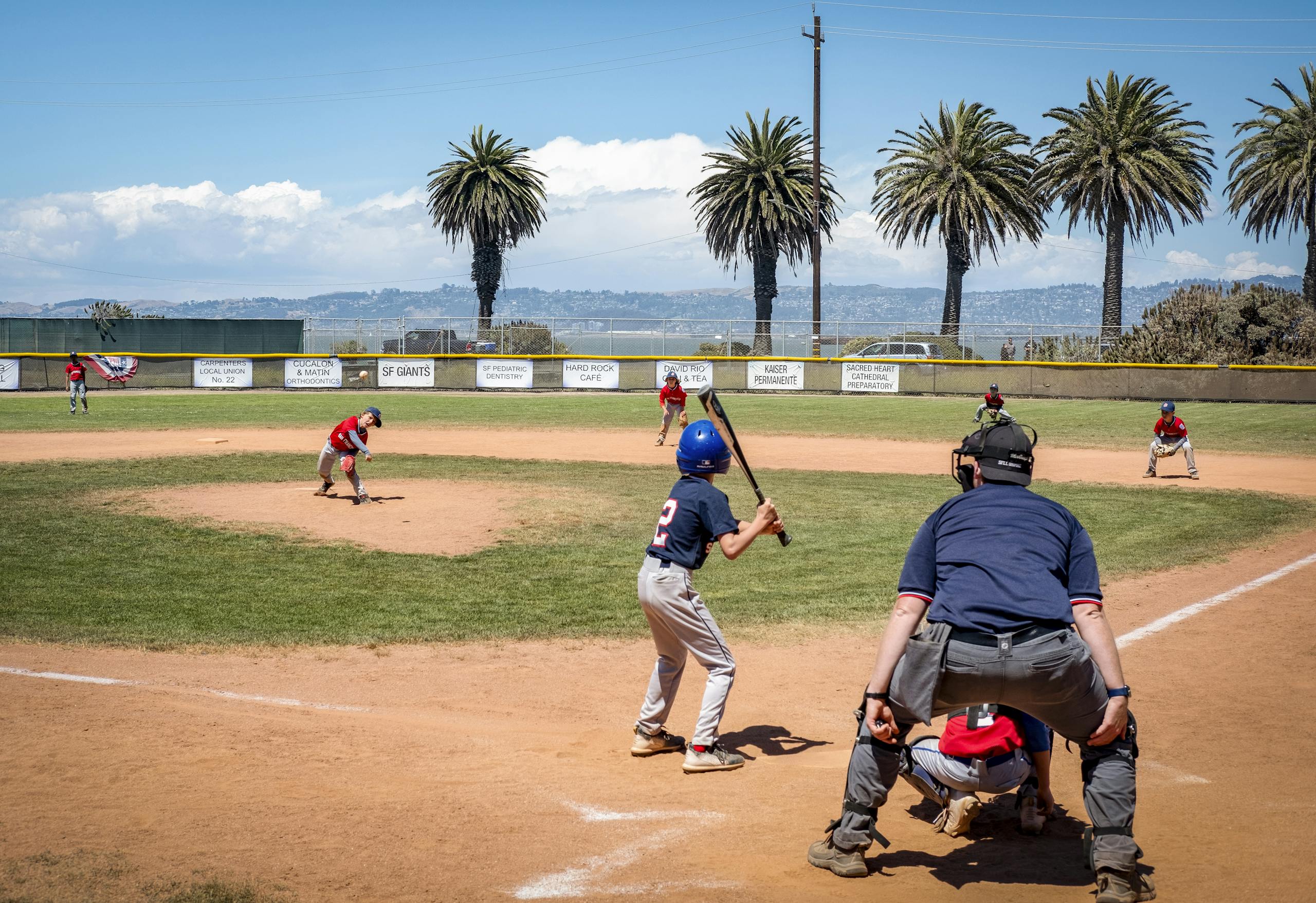Introduction
Stepping onto the field as a Little League coach for the first time is a significant responsibility. Whether you’re a parent coaching your son or daughter’s team or simply a baseball fan looking to give back to the community, your role as a coach is not just crucial to the team’s success, but also in shaping these young players’ experiences with the sport. You are the guiding force that can instill a lifelong love for the game in these budding athletes.
As a Little League coach, you’re not just teaching kids to hit a ball or field a grounder. You’re instilling life lessons, building character, and fostering a love for America’s pastime that can last a lifetime. Your influence extends beyond the diamond, impacting how they approach challenges, work as a team, and handle victory and defeat. Your commitment to their growth is invaluable, shaping them into well-rounded individuals both on and off the field.
Little League Coaching 101
This comprehensive guide will walk you through the essential skills and strategies you need to succeed as a new Little League coach.
Whether you need help managing a team or simply looking to refine your coaching skills, this blog will provide you the confidence to lead your team effectively.
Understanding Your Role
As a Little League coach, you wear many hats. Understanding your role is crucial to your success and the positive experience of your players. Let’s break down the critical aspects of your role:
Responsibilities of a Little League coach
Skill Development: Your primary responsibility is to teach and improve baseball skills, including hitting, fielding, throwing, and base-running techniques.
Safety First: Ensuring the safety of your players during practices and games is paramount. This involves proper warm-ups, teaching correct techniques, and maintaining a safe playing environment. By prioritizing safety, you can instill confidence in your players and their parents and create a secure environment for everyone involved.
Rules and Sportsmanship: You’re responsible for understanding and enforcing Little League rules and teaching players about fair play and good sportsmanship.
Team Management includes organizing practices, managing game lineups, and making in-game decisions.
Communication: You must effectively communicate with players, parents, umpires, and league officials.
Creating a positive team culture
A positive team culture can make the season enjoyable for everyone involved and contribute to player development. Here’s how to foster it:
- Lead by Example: Demonstrate the behavior and attitude you want to see in your players. Show respect to umpires, opponents, and your own team members.
- Encourage Teamwork: Create opportunities for players to work together and support each other. Use team-building exercises and encourage players to cheer for their teammates.
- Positive Reinforcement: Praise effort, improvement, and good sportsmanship. Create an environment where players feel safe to try new things without fear of criticism.
- Fun Factor: Remember that Little League should be entertaining at its core. Incorporate games and lighthearted moments into practices and team gatherings.
Little League Coaching 101
By understanding these aspects of your role, you’ll be well-equipped to create a positive, developmental environment for your Little League team. Remember, your influence extends far beyond the baseball diamond – you’re helping to shape young athletes into well-rounded individuals.
Practice and Management
Effective practice planning and management are essential for developing players’ skills and maintaining their enthusiasm for the game. Let’s break down the key components:
Creating Effective Practice Schedules
- Consistency: Aim for regular practice times (e.g., twice a week) to help families plan.
- Duration: Keep practices to 60-90 minutes for younger players and up to 2 hours for older ones.
- Structure: Follow a consistent structure:
- Warm-up (10-15 minutes)
- Skill work (30-45 minutes)
- Team drills or scrimmage (20-30 minutes)
- Cool down and recap (5-10 minutes)
- Variety: Rotate through different skills in each practice to maintain interest.
- Flexibility: Be prepared to adjust your plan based on team needs or unforeseen circumstances.
- Progressive Difficulty: Start with basic skills and gradually increase complexity as the season progresses.
- Off-field Planning: Spend time before each practice outlining your goals and activities.
Essential Drills for Skill Development
- Hitting Drills:
- Tee work: Focus on proper stance and swing mechanics
- Soft toss: Improve hand-eye coordination and timing
- Live batting practice: Simulate game situations
- Fielding Drills:
- Ground ball practice: Work on proper fielding technique
- Pop fly drills: Teach correct positioning and catching
- Infield/outfield practice: Improve throwing accuracy and communication
- Pitching Drills:
- Target practice: Enhance accuracy and control
- Pitching mechanics: Focus on proper form and follow-through
- Pickoff moves: Practice holding runners and fielding position
- Base Running Drills:
- Home to first: Improve speed out of the batter’s box
- Rounding bases: Teach proper technique for turning corners
- Stealing bases: Practice quick starts and sliding
- Team Defense Drills:
- Rundown practice: Improve coordination between fielders
- Cutoff and relay drills: Enhance communication and throwing accuracy
- Situation drills: Practice common game scenarios

Keeping Practices Fun and Engaging
- Incorporate Games:
- Hitting contests: Reward points for hitting to specific fields
- Fielding challenges: Use targets or time limits to add excitement
- Base running races: Make speed and agility training competitive
- Use Station-based Training:
- Divide the team into small groups
- Rotate through different skill stations every 10-15 minutes
- Keeps players active and prevents boredom
- Encourage Peer Teaching:
- Pair more experienced players with beginners
- Builds leadership skills and team camaraderie
- Provide Positive Feedback:
- Offer specific praise for effort and improvement
- Create a supportive environment where players feel safe to try new things
- End with Scrimmages:
- Finish most practices with mini-games
- Allows players to apply skills in game-like situations
- Mix in Non-Baseball Activities:
- Incorporate general athletic development (agility, balance, coordination)
- Use occasional non-baseball games to build team spirit
- Celebrate Achievements:
- Recognize individual and team progress regularly
- Consider small prizes or privileges for standout effort or improvement
Remember, the key to effective practices is balancing skill development with enjoyment. Creating a positive, engaging environment will help your players develop a lasting love for the game while improving their abilities on the field.
Game Day Management
Effective game-day management is crucial for a successful Little League season. It involves careful preparation, quick thinking during the game, and thoughtful reflection afterward.
Pre-game Preparation
Lineup and Position Planning:
– Prepare your batting order and defensive positions in advance
– Consider player rotations to ensure fair playing time
Warm-up Routine:
– Develop a consistent pre-game warm-up routine (e.g., light jog, stretching, throwing)
– Include brief fielding and hitting practice
Team Meeting:
– Gather the team for a short, positive meeting
– Review key strategies and remind players of team goals
– Encourage focus and good sportsmanship
In-game Decision Making
Substitutions and Rotations:
– Keep track of playing time to ensure all players get opportunities
– Make defensive adjustments based on game situations and player strengths
Pitching Management:
– Monitor pitch counts closely
– Have relief pitchers warming up when necessary
– Make timely pitching changes to protect young arms
Offensive Strategy:
– Decide when to bunt, steal, or play aggressively
– Adjust batting order if needed (e.g., in case of late arrivals or early departures)
Player Management:
– Keep players engaged, even when they’re not in the game
– Provide encouragement and quick tips between innings
Post-game Analysis and Team Discussions
Immediate Post-game Huddle:
– Gather the team for a brief meeting right after the game
– Highlight positive aspects of the team’s performance
– Address any immediate concerns or questions
Cool-down and Clean-up:
– Ensure players properly cool down and hydrate
– Assign clean-up duties (equipment collection, dugout cleaning)
Individual Player Feedback:
– Provide specific, constructive feedback to players
– Focus on effort and improvement, not just results
Parent Communication:
– Briefly address parents about the game and any upcoming events
– Be positive and focus on team progress
Plan Ahead:
– Start thinking about the next practice or game
– Consider how to address any issues that arose during the game
Little League Coaching 101
Remember, the goal of game day management is not just to win but to create a positive, developmental experience for your players. By being well-prepared, making thoughtful decisions, and providing constructive feedback, you’ll help your team grow as baseball players and individuals.
Player Development
Player development is at the heart of Little League coaching. Your role is to help players improve their skills, understand the game better, and grow as athletes and individuals. Let’s break down the critical components of player development:
Teaching Fundamental Skills
- Hitting:
- Proper stance and grip: Feet shoulder-width apart, hands together on the bat
- Eye on the ball: Teach players to watch the ball all the way to the bat
- Swing mechanics: Emphasize a level swing and follow-through
- Bunting: Teach proper technique for sacrifice and drag bunts
- Drill idea: Use a tee to break down the swing into parts (stance, load, swing, follow-through)
- Fielding:
- Ready position: Knees bent, hands out front, on the balls of their feet
- Glove positioning: Teach players to keep their gloves down and out front
- Footwork: Proper approach to ground balls and fly balls
- Two-handed catching: Emphasize using both hands to secure the ball
- Drill idea: Roll grounders to players, gradually increasing speed and varying directions
- Throwing:
- Grip: Teach the four-seam grip for accuracy
- Arm action: Emphasize a full arm circle for power
- Stepping: Stress the importance of stepping towards the target
- Follow-through: Teach players to follow through down and across their body
- Drill idea: Partner throws focusing on proper mechanics, gradually increasing distance
Age-Appropriate Training Techniques
- T-Ball and Coach Pitch (Ages 4-7):
- Focus on basic motor skills and hand-eye coordination
- Use more giant, softer balls for easier catching
- Emphasize fun and participation over competition
- Keep instructions simple and demonstrations clear
- Minor League (Ages 7-11):
- Introduce more complex skills like pitching and base stealing
- Begin teaching game strategy and situational play
- Use modified games to reinforce specific skills
- Encourage players to try multiple positions
- Major League (Ages 10-12):
- Refine individual skills and techniques
- Introduce more advanced strategies and mental aspects of the game
- Increase the intensity and competitiveness of practices
- Begin to specialize positions based on player strengths
Remember, the goal of player development in Little League is to create better baseball players, foster a love for the game, and build character. Focusing on fundamentals, using age-appropriate techniques, and encouraging individual growth will help your players develop skills far beyond the baseball diamond.
Communication Skills
Effective communication is a cornerstone of successful Little League coaching. It involves clear, consistent, and positive interactions with parents, players, fellow coaches, and league officials. Let’s break down the key components:
Working with Parents and Managing Expectations
- Pre-season Parent Meeting:
- Hold a meeting to introduce yourself and your coaching philosophy
- Clearly communicate expectations for player participation, behavior, and parent involvement
- Discuss the balance between competition and player development
- Explain your communication methods (e.g., email, team app, text messages)
- Regular Updates:
- Send weekly emails or messages about upcoming games, practices, and team news
- Share positive highlights about the team and individual players
- Open Door Policy:
- Be approachable for parent concerns or questions
- Set boundaries for appropriate times to discuss issues (not during games or practices)
- Managing Playing Time Expectations:
- Clearly explain your policy on playing time and position rotation
- Be prepared to have difficult conversations about player abilities and roles
- Educating Parents on Youth Sports:
- Share resources about the benefits and challenges of youth sports
- Encourage positive sideline behavior and sportsmanship
- Handling Conflicts:
- Address issues promptly and privately
- Focus on solutions rather than blame
- If necessary, involve league officials in mediation
Effective Communication with Players
- Age-Appropriate Language:
- Use terms and concepts that match the players’ understanding
- Break down complex ideas into simple, actionable steps
- Positive Reinforcement:
- Offer specific praise for effort and improvement
- Use a 5:1 ratio of favorable to constructive feedback
- Active Listening:
- Pay attention to players’ verbal and non-verbal cues
- Ask open-ended questions to encourage player input
- Clear Instructions:
- Demonstrate skills or concepts when explaining them
- Check for understanding by having players repeat instructions
- Individual Conversations:
- Make time for one-on-one interactions with each player
- Discuss individual goals and progress regularly
- Team Meetings:
- Hold brief team meetings before and after games and practices
- Encourage player input and questions
- Body Language Awareness:
- Be mindful of your own body language and tone
- Model the positive attitude you want to see in your players
- Handling Mistakes:
- Use errors as teaching opportunities, not punishment
- Encourage players to learn from mistakes and move forward
Building Team Chemistry and Motivation
Creating a solid team spirit and maintaining player motivation are crucial aspects of successful Little League coaching. A cohesive team with high morale is likelier to enjoy the game, support each other, and perform well. Here’s how to foster these qualities:
Team-building Activities and Exercises
- Ice Breakers:
- Start the season with fun get-to-know-you games
- Example: “Two Truths and a Lie” about baseball experiences
- Team Rituals:
- Develop pre-game or post-game rituals (e.g., team chant, high-five line)
- Create a team nickname or slogan
- Off-field Activities:
- Organize team picnics or pizza parties
- Arrange team outings to watch professional or college games
- Team Challenges:
- Set group goals (e.g., team fielding percentage) and celebrate achievements
- Create friendly competitions within the team (e.g., most improved player of the week)
- Buddy System:
- Pair up players to support and encourage each other
- Rotate pairs to build relationships across the team
- Team Service Projects:
- Engage in community service as a team (e.g., park clean-up, food drive)
- Builds camaraderie while teaching social responsibility
- Team-building Drills:
- Incorporate drills that require teamwork and communication
- Example: Relay throwing contests or group fielding challenges
Positive Reinforcement Techniques
- Specific Praise:
- Offer detailed, genuine compliments on effort and improvement
- Example: “Great job keeping your eye on the ball during that at-bat, Sarah!”
- Effort Recognition:
- Acknowledge hard work, regardless of the outcome
- Celebrate personal bests and individual progress
- Player of the Game:
- Recognize a standout player after each game (not always the best performer)
- Consider factors like sportsmanship, teamwork, and effort
- Team Accomplishment Board:
- Create a visible board to track team and individual achievements
- Update regularly and celebrate milestones
- Positive Feedback Ratio:
- Aim for a 5:1 ratio of favorable to constructive feedback
- Find opportunities to praise good behavior and effort
- Immediate Reinforcement:
- Offer praise or high-fives immediately after good plays or efforts
- This helps solidify the connection between positive actions and recognition
- Leadership Opportunities:
- Rotate team captain roles or allow players to lead warm-ups
- Recognizes and develops leadership skills
Handling Wins, Losses, and Player Morale
- Emphasize Effort Over Outcome:
- Focus on the process and improvement rather than just the final score
- Celebrate good plays and efforts in both wins and losses
- Constructive Post-game Discussions:
- After losses, focus on learning opportunities and areas for improvement
- After wins, reinforce positive behaviors that contributed to success
- Manage Expectations:
- Help players set realistic, achievable goals
- Teach that losses are a natural part of sports and an opportunity to learn
- Model Emotional Control:
- Demonstrate composed behavior in both victory and defeat
- Teach players to be gracious winners and resilient losers
- Individual Check-ins:
- Have brief one-on-one conversations with players, especially after challenging games
- Listen to their concerns and offer encouragement
- Team Reflection Sessions:
- Periodically hold team meetings to discuss the season’s progress
- Encourage players to share their thoughts on team dynamics and morale
- Redirect Negative Attitudes:
- Address negative behavior or comments quickly and privately
- Help players reframe negative situations in a more positive light
- Celebrate Small Victories:
- Recognize improvements and achievements beyond just winning games
- This helps maintain motivation during challenging stretches
- Keep It Fun:
- Incorporate fun drills or games into practices, especially after losses
- Remind players why they love baseball and the joy of playing
- Team Bonding After Losses:
- Use losses as an opportunity to bring the team closer
- Example: Team ice cream outing after a tough loss to lift spirits
Remember, as a Little League coach, your attitude and approach significantly influence team spirit and player motivation. By consistently implementing these strategies, you can create a positive team culture where players feel supported, motivated, and excited to play baseball. This positive environment enhances performance and ensures that players have a rewarding and enjoyable Little League experience.
Conclusion:
Congratulations on taking the first steps toward becoming an effective Little League coach! Stepping into the role of a Little League coach can seem daunting, but remember:
- Every experienced coach was once a beginner. Be bold and learn as you go.
- Your greatest assets are your passion for the game and your commitment to your players’ development.
- The impact you have on young players extends far beyond the baseball diamond.
- Embrace the challenges and joys of coaching – each season brings new growth opportunities.
- Remember to have fun! Your enthusiasm will be contagious to your players.
Coaching Little League is a rewarding experience that allows you to shape young lives, build community, and share your love of baseball. Trust your abilities, stay open to learning, and enjoy the journey.
Additional Resources for Continued Learning
To further develop your coaching skills, consider exploring these resources:
- Little League Coach Resource Center:https://www.littleleague.org
- USA Baseball Mobile Coach App: Available for iOS and Android devices
- Books:
- “Coaching Youth Baseball the Ripken Way” by Cal Ripken Jr. and Bill Ripken
- “The Baseball Drill Book” by the American Baseball Coaches Association
- Online Courses:
- National Alliance for Youth Sports (NAYS) coaching courses
- Positive Coaching Alliance workshops
- Local Clinics and Workshops: Check with your local Little League or parks and recreation department for coaching clinics
- Mentorship: Connect with experienced coaches in your league for guidance and advice
- Baseball Coaching Websites and Blogs:
- Social Media: Follow reputable youth baseball coaching accounts on platforms like Twitter and Instagram for daily tips and drills
Remember, coaching is a journey of continuous learning. Stay curious, be open to new ideas, and always prioritize the well-being and development of your players. Your dedication to improvement will not only make you a better coach but also enhance your team’s Little League experience.
Best of luck in your coaching journey, and play ball!






